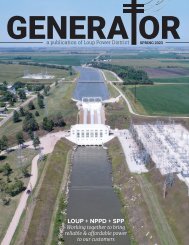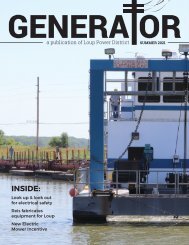Loup Generator — Fall 2020
The Ruthie cabin cruiser makes a big splash in 1939, the Lake Babcock Amusement Resort works to develop the lake into a "boating mecca", protecting the piping plover and interior least tern at the Genoa Headworks.
The Ruthie cabin cruiser makes a big splash in 1939, the Lake Babcock Amusement Resort works to develop the lake into a "boating mecca", protecting the piping plover and interior least tern at the Genoa Headworks.
You also want an ePaper? Increase the reach of your titles
YUMPU automatically turns print PDFs into web optimized ePapers that Google loves.
GENERA OR<br />
a publication of <strong>Loup</strong> Power District FALL <strong>2020</strong><br />
LAKE BABCOCK<br />
AMUSEMENT RESORT<br />
Group developed lake’s recreation in late ’30s<br />
Cabin cruiser makes a big splash in ’39<br />
Protecting birds at Genoa Headworks
BOARD<br />
OF DIRECTORS<br />
Chris Langemeier<br />
Chairman<br />
Ross Knott<br />
First Vice Chairman<br />
Alan Drozd<br />
Second Vice Chairman<br />
Steve Heesacker<br />
Secretary<br />
Dick Tooley<br />
Treasurer<br />
Rich Aerni<br />
Robert Cerv<br />
Jim Donoghue<br />
Mike Fleming<br />
Larry Zach<br />
EXECUTIVE STAFF<br />
Neal Suess<br />
President/CEO<br />
Walt Williams<br />
Vice President,<br />
Accounting & Finance/CFO<br />
Todd Duren<br />
Vice President,<br />
Corporate Services<br />
Korey Hobza<br />
Vice President, Engineering<br />
Dan Hellbusch<br />
Vice President, Operations<br />
The <strong>Loup</strong> <strong>Generator</strong> is<br />
published quarterly as a<br />
service for <strong>Loup</strong> employees,<br />
families, friends and<br />
associates.<br />
For feedback, story ideas<br />
and submissions, contact:<br />
Stacy Wemhoff<br />
Communications Coordinator<br />
402-562-5711<br />
swemhoff@loup.com<br />
Electrical Safety:<br />
Pet-Proof Your Home<br />
Puppies and kittens are cute and curious.<br />
The cute part can sometimes keep them<br />
from getting into trouble, like when they<br />
start chewing on a shoe. But cute won’t<br />
help them if they begin to chew on or play<br />
with electrical equipment<strong>—</strong> doing that can<br />
put your pet in serious danger of injury or<br />
death and create a shock or fire hazard<br />
in the home. Spending a little time petproofing<br />
your home will help you avoid a<br />
pet-related accident.<br />
• Make sure all plugs are inserted<br />
completely into their wall sockets.<br />
Small paws, noses and tongues can<br />
easily find their way into the partially<br />
exposed prongs.<br />
• If your pet demonstrates an interest<br />
in electrical cords, check the cords<br />
frequently for signs of fraying and<br />
replace any damaged cords immediately.<br />
If you must leave your pet unsupervised,<br />
make sure any loose electrical cords are<br />
unplugged or tucked out of sight. If your<br />
pet continues to seek them out, coat the<br />
cords with bitter-tasting pet deterrent<br />
available at your local pet store. If that<br />
fails, you can wrap the cords in flexible<br />
cable, or encase them in PVC. Some<br />
stores also offer pet-proof cords that<br />
serve the same purpose.<br />
• Take special care during the holiday<br />
season. Pets may be tempted to chew<br />
on, or play with decorative light strands.<br />
• Appliances near sinks and bathtubs<br />
should only be plugged into outlets<br />
equipped with ground fault circuit<br />
interrupter (GFCI) protection<br />
in case an electrical appliance is knocked<br />
into the water. If your cat enjoys playing<br />
in the sink, make sure no electrical<br />
appliances (like radios or curling irons)<br />
are left unattended on the bathroom<br />
counter.<br />
• Lamps with exposed bulbs <strong>—</strong> especially<br />
halogens <strong>—</strong> can reach very high<br />
temperatures. Do not allow pets to play<br />
near lamps. If the lamp is knocked over,<br />
a fire could break out.<br />
• Some pets, especially cats, will often<br />
seek out warm, secluded spots in the<br />
home. Do not allow your pet to hide<br />
or sleep behind your computer, or TV<br />
equipment where numerous electrical<br />
connections are housed.<br />
• If you have an aquarium, make sure you<br />
create a drip loop on every electrical<br />
cord that enters the tank. This will<br />
prevent water from running down the<br />
cord and into the electrical outlet. Stick<br />
a cord clip on the wall just below the<br />
outlet and thread the cord into the clip<br />
to ensure the cord stays looped.<br />
• If you have a fenced, outdoor area<br />
for your dog, be mindful of any<br />
underground electrical or cable lines<br />
running through that area. Make sure<br />
the lines are buried at appropriate<br />
depths, especially if your dog likes to dig.<br />
In the event of an electrical storm, bring<br />
all pets indoors immediately.<br />
If you think your pet may have suffered an<br />
electrical shock, approach it with caution<br />
to keep from being injured by the same<br />
electrical danger, and to keep from being<br />
bitten. Inspect the animal for injuries and<br />
get your pet to an animal care center as<br />
soon as possible.<br />
Heed the precautions to keep<br />
your playful pet and your<br />
home safe.<br />
<strong>—</strong> from safeelectricity.org<br />
2 GENERATOR
PRESIDENT'S MESSAGE<br />
Covid-19 update: business<br />
as usual is anything but<br />
As we enter the fall season, the entire world is still wrestling with the impact of<br />
the coronavirus and the Covid-19 pandemic. The District has responded in many<br />
different ways to this pandemic.<br />
Early on, the District closed its offices to the public, and went to half staffing most<br />
days. This was done in order to limit contact between individuals and provide the<br />
opportunity to keep the workplace clean. As the pandemic went on, the District<br />
went back to full staffing, but still kept the public out of our buildings. Again, this<br />
was done as a precaution to protect both employees and our customers.<br />
Finally, in early July, the District reopened the offices to the outside public, with<br />
some specific restrictions regarding traffic patterns for the public and meetings<br />
with outside individuals. These restrictions are still in place today.<br />
Many people have asked when things will get back to “normal.” I am not sure what<br />
normal is, and I am not sure we will ever get back to the way it was prior to this<br />
pandemic <strong>—</strong> at least not until a vaccine is developed and accessible to everyone.<br />
by NEAL SUESS<br />
President/CEO<br />
District employees are continuing to go about their daily activities during this<br />
pandemic, but it is definitely different. Most meetings are virtual, and I even<br />
attended the American Public Power Association (APPA) annual convention<br />
virtually. The APPA annual convention has always been a great convention for<br />
<strong>Loup</strong> Power District. This allows our Board and management to meet with other<br />
utility executives, as well as consultants and vendors, who provide products for the<br />
District. Having this convention virtually was very different. Being unable to meet<br />
people in person is very difficult for all of us.<br />
District crews continue to work on numerous projects, and new construction<br />
activity continues throughout the District’s service territory. This is one thing that<br />
has amazed me during the pandemic <strong>—</strong> the construction just keeps on going. This<br />
truly shows the mindset of individuals in Nebraska.<br />
During the midst of the pandemic, the District also finalized the move into our new<br />
Service Center in Columbus along Lost Creek Parkway. Many of you want to see<br />
what this looks like, and we are planning an open house as soon as the pandemic<br />
allows. The new Service Center has really helped the District and has improved our<br />
response to customers’ needs, as well as improved the efficiency of the District as a<br />
whole.<br />
Everyone has responded to the pandemic in different ways, and the District is no<br />
different. We will continue to respond as conditions warrant and continue to let the<br />
public know about our plans. All of us at <strong>Loup</strong> Power District hope you and your<br />
families continue to stay safe and be careful, as we do want to see and get back<br />
together with you when this is over.<br />
Until next time, be happy and stay safe!<br />
FALL <strong>2020</strong> 3
Ruthie’s<br />
BIG SPLASH<br />
THE<br />
<strong>—</strong> Columbus Telegram, May 27, 1940<br />
In 1939, Leonard Fleischer bought a boat from Chicago and<br />
brought it south to Richland where it was reconditioned.<br />
He named it Ruthie, after his soon-to-be wife, Ruth Schmid.<br />
The boat was big news when it hit the waters of Lake Babcock<br />
the following spring. It was, after all, one of the largest boats in<br />
Nebraska. His sons, Len and Bud, were small children during its<br />
heyday and remember only a few details.<br />
“He would give rides for 25 cents a gallon or a gas coupon,”<br />
said Len. “They were short of gas. He was a salesman and needed<br />
gas for his car.”<br />
His efforts to operate his cruiser began in March of 1940 when<br />
he petitioned <strong>Loup</strong> President Harold Kramer for permission.<br />
“I would like to ask permission from the <strong>Loup</strong> River Public<br />
Power District to launch and keep on Lake Babcock for the<br />
summer, a thirty-one foot cabin cruiser. I would also like to have<br />
a private dock for loading and anchoring of a craft of this size,<br />
which is greatly in need of this protection,” he wrote.<br />
<strong>Loup</strong> told Leonard his request was approved in a letter dated<br />
May 11, 1940. He signed a year-long permit “to operate motor<br />
boat on Lake Babcock for commercial purpose” the next month<br />
with the Lake Babcock Amusement Resort (more about this on page<br />
6). The cost was $25.<br />
Sometime in the early 1940s, the boat was requisitioned by<br />
the United States Coast Guard for use in World War II where<br />
it patrolled the Gulf of Mexico near New Orleans. It came back<br />
painted another color with mounting holes from a machine gun,<br />
Len said. It was repainted and repaired once more.<br />
Leonard received the boat back before 1944. The <strong>Loup</strong> Board<br />
minutes from Aug. 4 that year state that he removed his boat<br />
and housing from District property with the exception of a small<br />
screened shelter. He requested permission to move that shelter to<br />
higher ground off the south reservoir embankment. Permission<br />
was granted.<br />
The boat remained popular at the lake until the late 1940s<br />
when his sons estimate he sold it.<br />
4 GENERATOR
“<br />
Troubles and bubbles notwithstanding,<br />
Leonard Fleischer is going to stick it out on<br />
Lake Babcock . . . It’s a matter of record that<br />
the landlubber mariner hasn’t had clear sailing with his<br />
craft. Not that “The Ruthie” isn’t seaworthy, because<br />
she’s the acme in craft building for her size, but the<br />
elements are another reckoning.<br />
In the special building he has erected to house “The<br />
Ruthie” when not in the water, Cap’n Fleischer has toiled<br />
nearly every weekend for months on end fixing this, or<br />
painting that.<br />
Fleischer’s latest bitter pill came last Saturday night.<br />
“The Ruthie” was anchored on the lake. A heavy wind<br />
came up. Waves lashed against the craft in sufficient<br />
force to crash the rudder so sharply against the side a few<br />
boards were smashed . . .<br />
Doggedly, the process of repair and cleaning out was<br />
pursued this week, and Fleischer optimistically predicted<br />
yesterday his erstwhile study craft will again dip its nose<br />
into Lake Babcock ere another week is past.”<br />
<strong>—</strong> Columbus Telegram, May 24, 1941<br />
Opposite page: The Ruthie at<br />
the Walter Schmid farm near<br />
Richland where it was stored<br />
and reconditioned before it<br />
was taken to Lake Babcock.<br />
Above: Leonard Fleischer’s<br />
in-laws pose by the Ruthie<br />
on the <strong>Loup</strong> canal bank.<br />
Left: A Cabin Cruiser Ticket<br />
from 1940.<br />
Below: Fleischer’s permit to<br />
operate The Ruthie on lake<br />
Babcock.<br />
FALL <strong>2020</strong> 5
the WPA, the PWA and the <strong>Loup</strong> District have one master,<br />
the people, and we should all be cooperating.”<br />
He hoped that the WPA would reconsider and approve<br />
the project. A few months later, <strong>Loup</strong> was accepting<br />
sealed bids for coarse gravel and concrete riprap. The<br />
project was financed and constructed under the terms of<br />
Ttitle II of the National Industrial Recovery Act.<br />
By January of 1938, 29 WPA laborers were working to<br />
clear 1,000 feet of shoreline at the lake.<br />
“Almost from the time when the<br />
<strong>Loup</strong> River Public Power project was first proposed,<br />
a vision began to take form in the minds of many<br />
lovers of the out-of-doors in Columbus who began<br />
mentally picturing a piscatorial, camping and picnicking<br />
playground as a by-product of the huge undertaking.<br />
“When plans for the power canal and reservoir were<br />
announced, the vision began to<br />
take more definite shape. These<br />
visionaries with prophetic eye<br />
could see a summer paradise at<br />
Lake Babcock, the reservoir-tobe<br />
almost within the city’s front<br />
yard.”<br />
This was the news on June<br />
26, 1936, in The Columbus<br />
Daily Telegram. There was one<br />
big problem to making this<br />
Columbus dream a reality <strong>—</strong> a<br />
lack of money to do so.<br />
So, it was suggested that “businessmen and sportsmen<br />
organize their own voluntary project.” As an alternative,<br />
portions of the shore could be leased and developed<br />
privately.<br />
In August of 1937, <strong>Loup</strong> Secretary and General<br />
Manager Harold Kramer and his family spent a week at<br />
Lake Okoboji. They came back with plenty of ideas.<br />
“We have the advantage of benefiting by the<br />
experiences of these other watering places,” he<br />
said. “We start with a clean slate, and while our lake<br />
is comparatively smaller, nevertheless, it has the<br />
opportunity of becoming considerable of a spa in mid-<br />
Nebraska.”<br />
He told the Daily Telegram there were several<br />
problems that needed to be addressed before any<br />
development could occur.<br />
The most important was lack of land to develop.<br />
Kramer said District officials tried to acquire as<br />
much land as possible. However, the Public Works<br />
Administration (PWA) only allowed spending money for<br />
the hydroelectric project and not recreation development.<br />
The second problem was the lack of funds to<br />
bring in gravel to create a beach. The Works Progress<br />
Administration (WPA) had a plan to help with the project,<br />
but was unable because of a rule preventing the WPA and<br />
PWA from overlapping in one area.<br />
“A lack of coordination existed which was regrettable<br />
and which failed to bring an improvement to thousands<br />
of people in this whole territory,” Kramer said. “After all,<br />
6 GENERATOR<br />
“From all over the eastern half<br />
of Nebraska they come <strong>—</strong><br />
pleasure boat owners asking<br />
for permission to sail their crafts<br />
on the waters of Lake Babcock.”<br />
<strong>—</strong> Columbus Telegram, May 13, 1939<br />
Several boaters made headlines in the fall of 1938.<br />
The first was the Gray Goose <strong>—</strong> the lake’s first<br />
sailboat. The 10-foot boat was built by Leonard Miller<br />
and Emil Marx in the basement of the Miller home.<br />
They managed to get it out<br />
of the basement and to the lake,<br />
sailing two miles with “nary a<br />
mishap” on Sept. 14.<br />
The Gray Goose made news<br />
again five days later when it<br />
overturned and Leonard Miller<br />
and Miss Bettijane Malony hung<br />
on to the dinghy for more than a<br />
half hour for help.<br />
Next to make news was the<br />
Kingfisher, another homemade<br />
ship, built by Frederick Harris of<br />
Monroe. It was built of mahogany, oak and cypress, and<br />
was powered by a four-cyclinder Continental motor. It<br />
measured 17 feet from stem to stern.<br />
In February 1939, the Telegram reported that <strong>Loup</strong> was<br />
planning to officially open the lake to pleasure boating<br />
and possibly commercially operated boats.<br />
“Boating has been permitted to this extent <strong>—</strong> that the<br />
district, while not authorizing it, has not chased away<br />
the several venturesome spirits who have launched small<br />
boats on the surface of the lake.”<br />
An estimated 1,300 visited Lake Babcock on Sunday,<br />
May 21, 1939, to “watch the maneuverings of ‘sailors’<br />
and the coursings of boats on the big lake.”<br />
The District issued 106 permits to boat owners in 16<br />
towns including Lincoln, Omaha and Bruning.<br />
Development plans really started coming together by<br />
June that year.<br />
Herman Woerth received permission to sell live bait.<br />
Frederic Harris got the first commercial boating permit<br />
to sell rides in the Kingfisher. Refreshment stands were<br />
in the works.<br />
On June 8, 1939, the Lake Babcock Amusement Resort,
The Omaha World-Herald printed a picture<br />
taken from the Ruthie on Lake Babcock.<br />
The picture was also colorized and made<br />
into postcards.<br />
a non-profit association, was incorporated by 11 “publicspirited<br />
Columbus men.” Their goal was to promote and<br />
develop the recreational facilities of Lake Babcock.<br />
“Since Lake Babcock came into<br />
being, officials of the <strong>Loup</strong> River<br />
Public Power district have been<br />
‘stumped’ in figuring out some way<br />
to develop it as a real resort center,<br />
since, because of PWA regulations,<br />
the district could not use any of its<br />
funds on hand for that purpose,”<br />
the Telegram stated.<br />
All profits from the corporation’s<br />
efforts would go back into<br />
promoting the lake as a resort area.<br />
On June 10, the <strong>Loup</strong> board<br />
approved a lease granting exclusive<br />
amusement privileges of the lake to<br />
the corporation through July 5 for $1.<br />
The corporation was already planning a Fourth of July<br />
celebration to raise funds.<br />
REGATTA DRAWS LARGE CROWD<br />
An estimated 5,000 people attended the July 4th<br />
celebration. The entrance fee was 40 cents for all<br />
spectators over the age of 12. Fifteen boat owners offered<br />
rides on the lake for 25 cents.<br />
There were refreshment and novelty stands.<br />
The highlight was the races, with boats from<br />
Nebraska, Kansas, and Iowa. They topped speeds of 40<br />
miles per hour.<br />
The event also included a bait<br />
casting contest and surf board<br />
demonstrations.<br />
A 46-piece band featuring high<br />
school graduates from several towns in<br />
the <strong>Loup</strong> valley played for an hour.<br />
<strong>Loup</strong>’s diving crew gave a<br />
demonstration, with Bruce Albert in a<br />
diving suit and Walter Phillips guiding<br />
him.<br />
“Albert descended again to the floor<br />
of the lake, and presented something<br />
of an unexpected thrill for spectators<br />
when he tangled his air line for several<br />
minutes around a pier post, and was nearly struck by a<br />
floating log barricade in front of the speed dock,” noted<br />
the Telegram the following day.<br />
“With Phillips directing his course, Albert untangled<br />
himself without mishap, and made another journey into<br />
the lake.”<br />
The lake continued to draw as many as 500 spectators<br />
and visitors on the weekends through September 1939.<br />
<strong>—</strong> on page 8<br />
FALL <strong>2020</strong> 7
The amusement resort hoped to<br />
secure a long-term lease for Lake<br />
Babcock’s shoreline.<br />
But that proved more difficult than<br />
<strong>Loup</strong> officials and the corporation<br />
anticipated.<br />
On Dec. 26, 1939, the <strong>Loup</strong><br />
Board approved a 50-year lease<br />
for the Corporation, costing $1 per<br />
year. It granted exclusive use and<br />
development of Lake Babcock and<br />
adjacent lands through Jan. 1, 1989.<br />
The board had to rescind that lease<br />
a couple of months later because the<br />
PWA refused approval of the contract,<br />
insisting that <strong>Loup</strong> directors should<br />
retain direct supervision and control<br />
of the lake.<br />
In the end, the Board leased the<br />
lake to the Resort for one year,<br />
ending January 1, 1941.<br />
It was around this time that a local<br />
Sea Scouts unit organized.<br />
Sea Scouts is a Boy Scout program<br />
designed to improve boating skills<br />
and safety. The Columbus unit, called<br />
a ship, had 10 boys and young men.<br />
“Columbus Sea Scouts will be<br />
particularly favored because of the<br />
proximity of Lake Babcock as an<br />
ideal base of operations,” Skipper<br />
William Haney told the Telegram in<br />
November 1939.<br />
They did, indeed, become integral<br />
to Lake Babcock’s recreation.<br />
“Arrangements were made<br />
to have the Sea Scouts maintain<br />
the concession stand at the lake<br />
during the summer months. Their<br />
duties would be to maintain a 24<br />
hour service, protect the District’s<br />
property and boats of customers.<br />
8 GENERATOR<br />
Administer First Aid in cases of<br />
emergency, and issue boating<br />
permits at the Lake,” read the <strong>Loup</strong><br />
board minutes from July 10, 1940.<br />
In May 1940, the Yacht Inn opened<br />
at Lake Babcock. Sea Scouts Kenneth<br />
Mueller and Fred Raymond were the<br />
operators.<br />
“Through an arrangement with<br />
the Lake Babcock Amusement resort,<br />
the SS Half Moon, Columbus Sea<br />
Scout ship, has secured use of the<br />
residence along the lake shore and<br />
are offering a 24-hour service in soft<br />
drinks, coffee, sandwiches and other<br />
delicacies for boaters, anglers and<br />
sightseers,” reported the Telegram.<br />
The proceeds were to be used for<br />
nautical equipment and perhaps a<br />
base on one of the lake’s islands.<br />
A few months later, it was<br />
reported that they were doing well.<br />
“The boys do a rushing<br />
business on thirst annihilators and<br />
confections.”<br />
THE RESORT’S LAST YEARS<br />
In the spring of 1941, the Lake<br />
Babcock Amusement Resort was still<br />
active. F.O. Gottschalk, chairman of<br />
the boating committee, wrote a letter<br />
to Leonard Flesicher dated March 29,<br />
1941.<br />
“The association is very anxious to<br />
get facilities at Lake Babcock in good<br />
shape so that it will be a first-class<br />
boating resort,” he wrote.<br />
He was looking for people who<br />
might donate 50-gallon oil barrels<br />
for a dock since they had no money.<br />
He also suggested the formation of<br />
a boat club with a membership fee of<br />
$5 to help raise funds.<br />
That May, the Telegram reported<br />
that a 10-stall boat house had only<br />
two spots left.<br />
“Resort officers are more enthused<br />
than ever that Lake Babcock shores<br />
will eventually become a mecca for<br />
water sports lovers and picnickers.<br />
“They sagely admit popularity of<br />
substantial volume is a matter for the<br />
future . . . In the meantime, Resort<br />
officials are continually planning,<br />
and affording boaters and fisherman<br />
the best sport possible,” noted the<br />
Telegram on May 24, 1941.<br />
However, by the next year, the<br />
Amusement Resort was referred to as<br />
<strong>Loup</strong>’s “recreation committee.”<br />
A hunting debate at the lake<br />
was making more news than cabin<br />
cruisers and surfers.<br />
By November of 1942, the<br />
<strong>Loup</strong> Board agreed to pay for<br />
improvements made by the resort.<br />
“It was the general opinion of<br />
Board members present that such<br />
bills be paid by the District providing<br />
the work done and improvements<br />
made had some actual physical<br />
value toward the betterment and<br />
improvement of recreational facilities<br />
in connection with Lake Babcock.”<br />
It is unclear exactly when the<br />
Resort died out, but it was most likely<br />
late 1942 or 1943.<br />
The lake itself, had troubles of<br />
its own. Boaters began to diminish<br />
as anglers increased. The lake had<br />
been stocked and the fish had time to<br />
grow. An Telegram article from 1943<br />
notes it’s popularity.<br />
“Lake Babcock was probably the<br />
most popular spot in Columbus<br />
Sunday and Monday . . . The crappies<br />
were biting and this is the reason for<br />
the big attraction.”<br />
By the late 1940s, the lake began<br />
to fill with silt, making boating more<br />
difficult.<br />
Lake Babcock<strong>—</strong>and Lake North<br />
in later years<strong>—</strong>also lost some of its<br />
luster as bigger and better lakes came<br />
along.<br />
The Harlan County Dam and<br />
reservoir opened in 1952, followed a<br />
few years later by Lewis & Clark Lake.<br />
The Sherman Dam and reservoir<br />
were created in 1961.<br />
In the early 1960s, <strong>Loup</strong> began<br />
to study the feasibility of adding an<br />
extension to the lake.<br />
<strong>Loup</strong> officials decided the<br />
additional water storage was needed<br />
to provide the necessary electricity<br />
at peak requirement times. This was<br />
lest costly than dredging out Lake<br />
Babcock.<br />
When Lake North opened in 1964,<br />
it captivated local crowds much as<br />
Lake Babcock had more than 25 years<br />
earlier <strong>—</strong> hosting ski shows and<br />
other large events.<br />
Today, Lake Babcock is much<br />
quieter than it once was. Visitors<br />
seek wildlife and peace, rather than<br />
thrilling races.<br />
But that’s OK. At least the crappies<br />
are still biting.
watch out for<br />
SCAMS!<br />
Utility<br />
scammers are taking advantage<br />
of the pandemic and ramping up their efforts!<br />
They are often threatening and their phone numbers<br />
or emails may appear to be coming from <strong>Loup</strong> Power<br />
District or your local utility.<br />
Take note of these tips so you don’t become<br />
their next victim.<br />
DISCONNECTION<br />
DECEPTION<br />
PAYMENT<br />
METHODS<br />
Scammers may threaten<br />
to disconnect your power<br />
if you don’t follow their<br />
instructions.<br />
If the caller demands<br />
payment by gift card, cash,<br />
wire, or cryptocurrency, it is a scam.<br />
Legitimate companies don’t demand<br />
payment by these methods.<br />
DON’T GIVE OUT<br />
PERSONAL INFO<br />
Don’t give out banking<br />
or other personal info<br />
over the phone unless<br />
you made the call to a<br />
legitimate number.<br />
BE WARY OF<br />
IMMEDIATE<br />
PAYMENTS<br />
Scammers often say you<br />
must pay within a few hours<br />
to avoid disconnection.<br />
SHARE THESE TIPS<br />
Tell your friends and family<br />
about these scams so they<br />
can protect themselves.<br />
When people hear about<br />
scams, they’re more likely<br />
to avoid them.<br />
CONTACT US<br />
Your caller ID may say <strong>Loup</strong><br />
even if it is a scammer. If<br />
you are suspicious, hang up<br />
and call <strong>Loup</strong> or your local<br />
power provider at the number<br />
provided on your monthly<br />
statement.<br />
FALL <strong>2020</strong> 9
New Digital Governors<br />
for Monroe Powerhouse<br />
It’s time for an upgrade at the Monroe<br />
Powerhouse.<br />
The three digital governors are no longer<br />
supported by the manufacturer. The software is<br />
obsolete and the District has been using legacy<br />
equipment to interface with those governors.<br />
Because of these limitations, <strong>Loup</strong> replaced the<br />
first of three digital governors in July. The second<br />
will follow this month, with the third scheduled<br />
next year. The cost is around $300,000.<br />
“The purpose of the governor is to control speed<br />
of the generator and it does this by controlling the<br />
amount of water to the turbine with the wicket<br />
gates,” said Hydro Superintendent Brad Morton.<br />
The governors also function as auxiliary equipment<br />
controllers and provide mechanical protection for<br />
the generators. They do so by sounding alarms<br />
when something isn’t quite right, like temperature,<br />
oil pressure, or headwater levels. Each governor is<br />
configured with more than 200 alarms.<br />
The mechanical controllers were first upgraded<br />
in 1997. At that time, the Tainter Gate controls,<br />
powerhouse synthesizer, mechanical headwater<br />
level indicator, and other mechanical equipment<br />
was also digitized at a cost of about $535,000.<br />
That cost included fees to Voith Hydro, which<br />
helped design, engineer, and program the<br />
controllers. It also included fees for electricians<br />
and millwrights who installed the mechanical and<br />
electrical components.<br />
This time, Voith is again doing the design and<br />
commissioning work for the governors, but <strong>Loup</strong><br />
personnel is handling the rest of the work since<br />
only the electric components of the governors<br />
(inside the cabinets) are being replaced. The<br />
hydraulic and mechanical equipment replaced in<br />
1997 is still in good condition.<br />
The design for this upgrade began last year when<br />
<strong>Loup</strong> contacted Voith, based in York, Pa. After<br />
approval and engineering, the design went to a<br />
subcontractor for assembly.<br />
Morton was planning to travel to Philadelphia for<br />
factory testing of the new governors this spring.<br />
That plan was scrapped due to the Covid-19<br />
pandemic. Instead, Kent Matson, Lead Project<br />
Hydro Superintendent Brad Morton<br />
demonstrates how the old digital<br />
governors work. The new governors<br />
have an improved operator screens,<br />
as shown above.<br />
10 GENERATOR
Above: The inside of a digital<br />
governor cabinet at the Monroe<br />
Powerhouse.<br />
Right: The Monroe Powerhouse<br />
has three digital governors. The<br />
electric components are being<br />
replaced.<br />
Engineer at Voith, completed factory testing on site<br />
at the Monroe Powerhouse.<br />
Matson and <strong>Loup</strong> personnel followed a step-by-step<br />
procedure to calibrate the governor and make sure<br />
it interfaced correctly with auxiliary equipment.<br />
He also simulated different generator operations to<br />
ensure the alarms work correctly.<br />
Morton said these new governors are computerbased<br />
so they can be upgraded as needed. They are a<br />
definite improvement from the governors installed<br />
in 1997 and especially the original equipment dating<br />
to the 1930s.<br />
“When we went to digital governors we gained<br />
increased reliability and equipment protection that<br />
wasn’t available with the original equipment,”<br />
Morton said. “The digital governors made it possible<br />
to interface with SCADA systems and modern<br />
generator auxiliary support equipment.”<br />
Kent Matson, Lead Project Engineer at Voith Hydro, tested and<br />
commissioned the first of three digital governors at the Monroe<br />
Powerhouse in July.<br />
FALL <strong>2020</strong> 11
PROTECTING SHOREBIRDS<br />
AT THE GENOA HEADWORKS<br />
In 1985, the number of interior least terns dropped<br />
below 2,000 adults nesting in a few dozen sites along<br />
the Mississippi River.<br />
The U.S. Fish and Wildlife Service (USFWS) listed it as an<br />
endangered species that May.<br />
The following year, the USFWS named the Northern<br />
Great Plains population of the piping plover a<br />
threatened species.<br />
The birds have had different fates in the last 35 years.<br />
The interior least tern population has rebounded to<br />
18,000 in 18 states and the U.S. Fish and Wildlife Service<br />
is proposing to delist the species.<br />
The Northern Great Plains population of the piping<br />
plover, is still struggling to make a comeback. Their<br />
numbers have declined in some years, but still trend<br />
slightly upward.<br />
Michael Gutzmer, Principal of New Century<br />
Environmental (NCE) in Columbus, said climate<br />
patterns, predation, land use, and human encroachment<br />
are some of the major impediments to stable<br />
populations of these unique shorebirds in our Nebraska<br />
waters.<br />
“The stakes are high and unpredictable in reproductive<br />
success when the birds choose to nest in highly variable<br />
flow conditions like the <strong>Loup</strong> or Platte Rivers,” he said.<br />
“This may be part of the reason these birds are so rare.”<br />
TERN & PLOVER DECLINE<br />
Protecting wildlife was likely not a consideration in 1933<br />
when the <strong>Loup</strong> Project grant and loan was announced by<br />
the Public Works Administration.<br />
The Fish and Wildlife Service<br />
was created seven years<br />
later, in 1940. Congress<br />
passed the Endangered<br />
Species Act in 1973.<br />
The first record of<br />
both species was<br />
first recorded in the<br />
1940s. By this time,<br />
many hydroelectric<br />
projects around the<br />
state and country were<br />
complete.<br />
These projects <strong>—</strong> along with irrigation, development,<br />
and recreation<strong>—</strong> caused river channels to narrow, and<br />
vegetation to increase. In turn, the number of suitable<br />
nesting sandbars decreased.<br />
Over the years, the birds have expanded their habitat<br />
to include sand pits, lake housing developments, and<br />
reservoir shorelines.<br />
These are not always suitable nesting habitats, however,<br />
considering the amount of human interaction at these<br />
sites.<br />
ATVs and off-road vehicles can crush nests and kill<br />
birds. Because these birds nest on the open ground,<br />
they are more vulnerable to predators like raccoons,<br />
foxes, coyotes, opossums, skunks, river otters, and dogs.<br />
FERC LICENSE MANDATES<br />
For more than 80 years, the District has dredged sand<br />
from the settling basin at the Genoa Headworks.<br />
The two-mile settling basin fills with sediment as<br />
<strong>Loup</strong> River water enters the canal. It is removed using<br />
a hydraulic dredge and pumped to sand management<br />
areas to the north and south of the canal. This allows<br />
the water to more easily flow through the canal to<br />
powerhouses in Monroe and Columbus.<br />
Until the mid-1980s, dredging began in spring and<br />
continued through the fall. That changed when the<br />
birds were listed as threatened and endangered. At that<br />
time, <strong>Loup</strong> changed its dredging schedule to protect<br />
them from the sand and slurry that is pumped into their<br />
nesting areas.<br />
Those efforts continue today as mandated in the<br />
District’s federal hydroelectric license, issued in 2017 by<br />
the Federal Energy Regulatory Commission (FERC).<br />
The license requires that <strong>Loup</strong> cease dredging from<br />
the first sign of nests in June through August to reduce<br />
nest disturbances. Both birds nest by creating shallow<br />
depressions in open sand.<br />
The license requires that <strong>Loup</strong> monitor the presence<br />
and habitat of the interior least tern, piping plover, and<br />
rufa red knot for at least six years and submit an annual<br />
report documenting all studies. The District is currently<br />
in the third year of that plan, which began in 2018. (To<br />
date, no rufa red knots have been documented at the<br />
Genoa Headworks.)<br />
12 GENERATOR<br />
Piping plover at the Genoa Headworks. Photo by Michael Gutzmer.
Pair of nesting least terns.<br />
Photo by Michael Gutzmer.<br />
Gutzmer has worked with <strong>Loup</strong> since 2010, and is in<br />
the process of completing those studies. Gutzmer and<br />
his team will continue monitoring through 2023 when<br />
they will complete a final report.<br />
Their business serves as the environmental compliance<br />
arm for <strong>Loup</strong> <strong>—</strong> surveying bird populations and<br />
their habitats, and completing reports on fish, water<br />
pollution, invasive species, wetlands, and other<br />
environmental issues.<br />
In his work with <strong>Loup</strong>, Gutzmer has also conducted<br />
training and general awareness for <strong>Loup</strong> employees,<br />
showing them how to monitor the area for birds and<br />
nests. He also educates District employees about other<br />
applicable environmental regulations.<br />
NEW HABITAT AT HEADWORKS<br />
Although the <strong>Loup</strong> project changed the flow of the river<br />
in the 1930s, the dredging operation has created new<br />
habitat over all these years.<br />
“<strong>Loup</strong> has helped the species tremendously because we<br />
are creating habitat on the sand management areas,”<br />
said Chris Shank, <strong>Loup</strong>’s Civil Engineering Compliance<br />
Technician.<br />
Gutzmer echoed that observation.<br />
“The extraction and dredging of sand from the supply<br />
canal has created significant substrate for nesting<br />
opportunities at the Genoa Headworks,” he said. “<strong>Loup</strong><br />
can take credit in and around the entire canal system<br />
for creating many aquatic resource opportunities that<br />
might not otherwise exist.”<br />
Gutzmer said diversion also lowers flows in the bypass<br />
reach, creating more sand bars for bird nesting. NCE<br />
has formally documented this in FERC article studies.<br />
<strong>—</strong> continued on page 14<br />
Above left: a least tern with a fish in its beak. Photo by Kate Asmus.<br />
Above right: New Century Environmental employees Shailyn Miller and<br />
Jordan Kort and contract biologist Tony Bryne survey piping plover and<br />
least tern at the Genoa Headworks in May with the help of driver Bob<br />
Souillere. Photo by Michael Gutzmer.<br />
The Pawnee II dredges sand and sediment from the settling basin at the<br />
Genoa Headworks. It is pumped into sand management areas (shown<br />
below), creating new habitat for the piping plover and least tern. The<br />
district ceases dredging during the birds’ nesting season from June<br />
through August to protect the nests.<br />
FALL <strong>2020</strong> 13
Interior Least terns and piping plovers make<br />
shallow depressions on sandbars for their<br />
nests. Piping plovers typically lay four eggs<br />
and line the nest with pebbles (top photo),<br />
while least terns lay three eggs (bottom).<br />
Photos by Michael Gutzmer.<br />
A biological opinion issued by the U.S.<br />
Fish & Wildlife Service in 2016 also<br />
noted the positive impact of dredging<br />
on the bird populations.<br />
“Dredging has not only kept the<br />
canal open but has resulted in the<br />
generation and regeneration of<br />
interior least tern nesting habitat<br />
through the creation of these sand<br />
piles.”<br />
The report also noted without the<br />
dredging, vegetation would likely<br />
encroach into nesting areas, resulting<br />
in a loss of habitat.<br />
While annual bird surveys and<br />
dredging season limits are mandated<br />
in the District’s license, Shank<br />
said <strong>Loup</strong> is mindful of our natural<br />
resources and wants to be good<br />
stewards of those resources.<br />
This includes continuing to learn<br />
and gather information to better<br />
help both species.<br />
“We strive for conservation and the<br />
sustainability of these ecosystems<br />
and our operations,” he said.<br />
The Tern and Plover Conservation<br />
Partnership, based at the University<br />
of Nebraska-Lincoln, is also working<br />
to protect the birds along the Lower<br />
Platte, <strong>Loup</strong>, and Elkhorn Rivers.<br />
Elsa Forsberg is a lead technician<br />
with the group and conducts<br />
surveys at the Headworks during the<br />
summer, counting birds and checking<br />
nests.<br />
Numbers last year were disappointing<br />
due to flooding caused by a mid-<br />
March storm, but have improved this<br />
year.<br />
“The partnership with the Headworks<br />
provides additional off-river habitat<br />
and enables us to monitor and protect<br />
the nests there,” Forsberg said. “It is<br />
very valuable.”<br />
SUMMER <strong>2020</strong> BIRD SURVEY<br />
SURVEY DATE<br />
May 18–20<br />
June 2–3<br />
June 15–16<br />
July 1–2<br />
July 13–14<br />
INTERIOR LEAST TERN<br />
<strong>Loup</strong> River Bypass Lower Platte River<br />
6 14<br />
16 34<br />
17 34<br />
14 28<br />
7 27<br />
PIPING PLOVER<br />
<strong>Loup</strong> River Bypass Lower Platte River<br />
5 1<br />
1 2<br />
3 2<br />
7 0<br />
11 11<br />
Source: New Century Environmental<br />
Below left: A piping plover uses the “broken wing display” to defend its nest.<br />
Photo by Michael Gutzmer.<br />
Below right: A piping plover chick explores. Tern and plover nests, eggs,<br />
and chicks are well camouflaged, making them difficult to see.<br />
Photo by Kate Asmus.<br />
14 GENERATOR
PIPING PLOVER<br />
STATUS: Threatened<br />
DESCRIPTION: Small migratory shorebird bird about<br />
the size of a robin. Named for the melodic “piping”<br />
of its call. Sandy-colored back and white underparts.<br />
Single black neck band and a short orange bill with a<br />
black tip.<br />
NEBRASKA HABITAT: In Nebraska, the habitat of the<br />
piping plover has been reduced due to years of humancaused<br />
changes to natural river systems. Today piping Photo by Kate Asmus<br />
plovers nest along portions of the Missouri, Platte,<br />
Niobrara, <strong>Loup</strong>, and Elkhorn Rivers in Nebraska. They<br />
nest on river sandbars, lakeshore housing developments, reservoirs, and sand and gravel mines.<br />
NESTING: Piping plovers make shallow scrapes in the sand and line them with small pebbles. The female lays<br />
three to four eggs. Both parents share incubation duties. Eggs hatch in about a month and young leave the nests<br />
within hours, but remain near parents for a few weeks. The young can fly in 18–28 days.<br />
REASONS FOR DECLINE: Heavily hunted in the late 1800s for their feathers, which were used in the millinery (hat)<br />
trade. They started to rebound, but dam construction and water diversion changed river flow and reduced nesting<br />
habitat in the 1930s and 40s. Humans have also caused changes to the landscape and increased the number of<br />
predators. In the wintering grounds in Texas, beach development and sea level rise have also decreased habitat.<br />
DIET: Insects and small aquatic invertebrates.<br />
DEFENSIVE BEHAVIOR: Adults defend nests with a broken wing display. They make alarm calls, limp, and pretend<br />
to be injured to lead the intruder away from nest and chicks<br />
There are three populations of piping plovers. The Great Lakes population of piping plovers is endangered.<br />
The Northern Great Plains and Atlantic Coast populations are threatened.<br />
INTERIOR LEAST TERN<br />
STATUS: Endangered<br />
DESCRIPTION: The smallest members of the tern<br />
family, a little smaller than a robin. Deep forked tail.<br />
White body, black cap with white forehead, and light<br />
gray wings. Yellow bill with a black tip.<br />
NEBRASKA HABITAT: Interior least terns were once<br />
found in Nebraska throughout the major river systems,<br />
but their range has been reduced because of habitat<br />
loss. Today they nest along portions of the Missouri,<br />
Platte, Niobrara, <strong>Loup</strong>, and Elkhorn Rivers. They nest<br />
on river sandbars, reservoirs, lakeshore housing<br />
developments, and sand and gravel mines.<br />
NESTING: Nest in colonies. Lay 2 to 3 eggs in a small depression in bare sand. Eggs take about 21 days to hatch.<br />
The chicks typically leave the nests within two days of hatching, but depend on their parents for food and<br />
protection for about three weeks.<br />
REASONS FOR DECLINE: At the time of listing in 1985, the interior least tern was believed to have been eliminated<br />
from much of its summer nesting range by the construction of dams and other forms of river engineering, such as<br />
channelization, that inundated and destroyed their nesting islands and bars and altered flow regimes.<br />
DIET: Small fish.<br />
Photo by Platte River Recovery Implementation Program<br />
DEFENSIVE BEHAVIOR: Adults defend nest and chicks by mobbing, dive bombing, and defecating on intruders.<br />
Source: U.S. Fish & Wildlife Service | Tern and Plover Conservation Partnership<br />
FALL <strong>2020</strong> 15
employee notes<br />
KOREY HOBZA<br />
Vice President of Engineering<br />
Welcome<br />
Korey Hobza of Columbus joined <strong>Loup</strong> Power District as Vice President of Engineering<br />
in July.<br />
In his new role, Hobza provides leadership for the planning, design, maintenance and<br />
construction of the electric, transmission, distribution, and generation systems at <strong>Loup</strong><br />
Power. He also has supervisory responsibility for Engineering and Meter/Maintenance<br />
personnel as well as building and structures maintenance.<br />
Hobza previously served as Facilities Manager/Support Engineering Leader at BD<br />
Medical in Columbus, where he worked since 2007.<br />
He is a graduate of Leigh Public Schools and earned a Bachelor of Science Degree in<br />
Industrial Engineering from the University of Nebraska-Lincoln.<br />
He and his wife, Peggy, have two children: Hayden, 6, and Karleigh, 3.<br />
Promotion<br />
TRENT CRUMLEY<br />
Heavy Equipment Operator<br />
Trent Crumley has been promoted<br />
to Heavy Equipment Operator.<br />
Crumley joined <strong>Loup</strong> Power District<br />
in 2017 as the District’s Maintenance<br />
Man for the Hydro Department<br />
based out of the Columbus Service<br />
Center. In 2018, he was promoted to<br />
Equipment Operator.<br />
In his new role as Heavy<br />
Equipment Operator, Crumley is<br />
part of the crew that maintains the<br />
District’s canal system from Genoa to<br />
Columbus. He operates the District’s<br />
heavy equipment including draglines,<br />
loaders, backhoes, and trucks. He also<br />
works at the two powerhouses when<br />
needed, helps build substations, and<br />
maintains District parks and lakes.<br />
He is a graduate of Monroe High<br />
School. He and his wife, Shana, have<br />
two sons, Dylan and Ethan.<br />
Welcome<br />
JEREMY REIS<br />
Machinist/Welder<br />
Jeremy Reis joined <strong>Loup</strong><br />
Power District as Machinist/<br />
Welder in August.<br />
His duties include fabricating<br />
parts and equipment, repairing<br />
equipment and vehicles,<br />
welding, and maintenance work.<br />
Reis is a graduate of Albion<br />
High School and studied<br />
machine tool and welding at<br />
Central Community College-<br />
Columbus. He and his wife,<br />
Bridget, live in Genoa. He<br />
has two children and four<br />
stepchildren.<br />
Reis worked at Preferred<br />
Sands before joining <strong>Loup</strong>.<br />
5 Years<br />
KENTON ZIMMER<br />
Dredge/Maintenance<br />
Canal Tech<br />
Kenton Zimmer of Genoa has<br />
joined <strong>Loup</strong> Power District as a<br />
Maintenance Man at the Genoa<br />
Headworks in 2015.<br />
In 2017, he was promoted. In his<br />
current role as Dredge/Maintenance<br />
Canal Technician, he is a member of<br />
the crew responsible for the operation<br />
and maintenance of the dredge that<br />
removes sand and sediment from<br />
the settling basin of the <strong>Loup</strong> Canal.<br />
He also helps maintain the District’s<br />
equipment and facilities including<br />
Headworks Park.<br />
A native of Duncan, Zimmer is a<br />
graduate of Columbus High School.<br />
He attended Central Community<br />
College-Columbus.<br />
Zimmer and his wife, Betsy, are<br />
the parents of four children.<br />
16 GENERATOR
NEAL SUESS<br />
President/CEO<br />
Suess joined <strong>Loup</strong> in 2005 as President/CEO. He oversees all operations of <strong>Loup</strong> Power<br />
District and reports to the Board of Directors. The District’s operations include the sale<br />
and distribution of electricity in the four-county service territory, hydro generation, and<br />
economic development in the service area.<br />
During his 15 years at the helm, Suess has been involved in several milestone events<br />
at the District. They include the generating unit renovation at the Columbus and Monroe<br />
Powerhouses in 2007, electrical expansion construction at ADM Corn Processors east of<br />
Columbus, the commissioning of a new Dredge in 2012, and a new federal hydroelectric<br />
license in 2017. He has also helped coordinate repairs of the District’s Genoa Headworks<br />
caused by a storm in March 2019. He was also instrumental in bringing both Clarkson<br />
(2007) and Leigh (2018) on as retail towns.<br />
Suess holds a Bachelor of Science Degree in Mechanical Engineering from Iowa State<br />
University. He is a Registered Professional Engineer in Nebraska and a member of the<br />
American Society of Mechanical Engineers.<br />
Suess and his wife, Jo, have two children, Elizabeth (soon to be married to Collin Gilbert)<br />
and Taylor (married to Dani Pedersen) and one grandchild, Leo.<br />
15 Years<br />
10 Years<br />
CRAIG BAXA<br />
Powerhouse Operator<br />
Craig Baxa joined <strong>Loup</strong> in 2010 as a Maintenance<br />
Man at the Genoa Headworks. In 2012, he was promoted<br />
to his current position of Plant Operator at the<br />
Columbus Powerhouse.<br />
He is on a team of six Columbus Powerhouse<br />
operators who watch over <strong>Loup</strong>’s hydroelectric system.<br />
They monitor and control the generation units at the<br />
powerhouses in Columbus and Monroe. The operators<br />
also work closely with the Genoa Headworks Division<br />
to divert maximum water from the <strong>Loup</strong> River into the<br />
District’s canal system for power plant generation.<br />
Baxa is a graduate of Twin River High School.<br />
He attended Wayne State College where he earned<br />
a Bachelor of Science degree in Criminal Justice. He<br />
and his wife, Chelsi, live in Monroe and have one son,<br />
Chance.<br />
1 Year<br />
TODD DUREN<br />
Vice President of Corporate Services<br />
Todd Duren of Columbus joined <strong>Loup</strong> Power District<br />
in 2019.<br />
He is responsible for oversight of four departments<br />
<strong>—</strong> Development/Marketing, Information Technology,<br />
Human Resources, and Safety. He also oversees<br />
regulatory compliance in the HR and safety areas and<br />
provides leadership on economic development and<br />
public relations projects.<br />
Duren is a graduate of Scotus Central Catholic High<br />
School. He earned a degree in Civil Engineering from<br />
the University of Nebraska-Lincoln. He and his wife,<br />
Lisa, have three children <strong>—</strong> Anthony, 29, and his wife,<br />
Blair; Morgan, 27; and Jared, 23.<br />
In his free time, Duren enjoys duck hunting,<br />
cheering on the Huskers and hanging out with family<br />
and friends.<br />
FALL <strong>2020</strong> 17
<strong>Loup</strong> adds hybrid EV to fleet<br />
New public charging stations coming to Columbus<br />
<strong>Loup</strong> Power District offers several cash incentives to customers who<br />
purchase electric vehicles.<br />
The District has considered adding an electric vehicle to its fleet for a few<br />
years and moved forward with that plan after discovering an incentive of its<br />
own.<br />
<strong>Loup</strong> was one of eight utilities that received a $16,000 grant from the<br />
Nebraska Community Energy Alliance (NCEA) and Nebraska Environmental<br />
Trust (NET) for the purchase of an all-electric or hybrid vehicle.<br />
<strong>Loup</strong> used that grant money to purchase a Mitsubishi Outlander Plug-in<br />
Hybrid Electric Vehicle (PHEV).<br />
The all-wheel drive SUV will be used by District employees, especially<br />
Customer Service Representatives from Columbus who travel to other<br />
communities.<br />
“We wanted a more reliable vehicle for them to use in winter,” said Walt<br />
Williams, Vice President of Accounting & Finance/CFO.<br />
Williams said he is very impressed by the vehicle’s performance.<br />
“I think if people would drive it, they would realize it’s great option,” he<br />
said.<br />
The hybrid model also eliminates some anxiety because once the battery<br />
wears down, the vehicle will switch to gas power.<br />
Customer Service Representative Rhonda Rogers said the car is very quiet.<br />
“I have to look at the dashboard to make sure it is on,” she said.<br />
Accounting Clerk Lynette June also noted how quiet the Outlander is and<br />
appreciated the vehicle’s handling.<br />
“When I got it on the highway, the acceleration was very smooth,” she said.<br />
June also said it was easy to shift the car from drive to reverse and to put<br />
the car in park by simply hitting a button.<br />
The vehicle’s drive battery can be charged with a standard 120V power<br />
outlet at home with the supplied charging cable (full charge in eight hours), or<br />
with a public or residential 240V charging station (full charge in less than four<br />
hours).<br />
It also has DC Fast-Charging capability (commercial charging stations),<br />
charging up to 80 percent capacity in about 25 minutes.<br />
It has an all-electric range of about 22 miles before switching over to gas.<br />
<strong>Loup</strong> is also planning to install Level II public EV charging stations at its<br />
Columbus Service Center on the Lost Creek Parkway and at the Holiday Inn<br />
Express on East 23rd Street.<br />
An additional grant from the NCEA and NET will cover the costs of those<br />
two chargers. <strong>Loup</strong> will pay for labor and installation.<br />
Todd Duren, Vice President of Corporate Services, said as EVs become more<br />
popular, it makes sense for <strong>Loup</strong> to improve charger accessibility for the<br />
public.<br />
“Electric vehicles are the future and each year more models are being<br />
designed and released to the market,” he said.<br />
Duren said consumers in the Midwest may really embrace the technology<br />
when electric full-sized pickups and SUVs can travel more than 300 miles on a<br />
charge.<br />
In the meantime, today’s models are ideal for driving around town as<br />
well as short-distance commuters. Like Williams, Duren said people may be<br />
surprised when they test drive an electric or hybrid vehicle.<br />
“EVs offer an exciting and unique driving experience,” he said.<br />
Top: Walt Williams, Vice President of<br />
Accounting & Finance/CFO, analyzes data on<br />
the Mitsubishi Outlander PHEV dashboard.<br />
Bottom: Williams charges the SUV at the <strong>Loup</strong><br />
General Office. The battery can be charged<br />
with a standard 120V power outlet or with a<br />
public or residential 240V charging station.<br />
The PHEV also comes standard with DC Fast-<br />
Charging capability.<br />
18 GENERATOR
THREE DRIVE<br />
SYSTEM MODES<br />
The Outlander PHEV’s drivetrain combines a front electric motor, rear<br />
electric motor, and front-mounted gasoline-powered 2.0-liter engine<br />
with integrated generator.<br />
EV Drive Mode (Twin Motor S-AWC EV)<br />
In EV Drive Mode, the vehicle is driven by the two electric motors, with<br />
energy supplied exclusively by the lithium-ion battery pack. With the EV<br />
mode button, the driver can select this driving mode for 100% electricpowered,<br />
zero-emission driving, for up to 22 miles.<br />
Series Hybrid Mode<br />
(Twin Motor S-AWC EV with Internal Combustion <strong>Generator</strong>)<br />
When the energy level remaining in the lithium-ion battery pack is<br />
low, the two electric motors are powered by the battery pack and the<br />
gasoline-powered generator. The gasoline-powered generator helps<br />
charge the lithium-ion drive battery pack and provides power to the<br />
twin electric motors.<br />
Parallel Hybrid Mode<br />
(Gasoline-Powered Engine Supported by Twin Motor S-AWC)<br />
In this mode, the Outlander PHEV uses its full complement of resources:<br />
1) The 2.0-liter gasoline engine drives the front wheels; the front axle<br />
features a built-in clutch that switches the system to Parallel Drive Mode<br />
mainly for engine-powered travel at high speeds/steady-state cruise.<br />
2) The two electric motors operate seamlessly when additional power is<br />
required, such as driving uphill.<br />
Thinking about<br />
going electric?<br />
Look at these<br />
INCENTIVES!<br />
$4,500 | EV + CHARGER<br />
$4,000 incentive for the purchase<br />
of a new battery electric vehicle<br />
$500 incentive for the installation<br />
of a residential ChargePoint 32-amp,<br />
WI-FI-enabled vehicle charging station<br />
Charging station must be purchased and<br />
installed to receive the vehicle incentive<br />
PRE-WIRING<br />
$200 for new construction<br />
$400 for existing construction<br />
in-home pre-wiring for the future<br />
installation of an electric vehicle<br />
charging station<br />
3) The gasoline-powered engine/generator <strong>—</strong> while operating the<br />
vehicle at sufficient speed<strong>—</strong> will feed any excess energy (electricity) back<br />
into the lithium-ion battery pack.<br />
The Parallel Hybrid mode is most commonly engaged when<br />
the Outlander PHEV is driven in a long-haul/<br />
high-speed steady-state cruise manner,<br />
such as on the open road or<br />
interstate, where this drivetrain<br />
configuration is most efficient.<br />
Questions? Visit loup.com<br />
or call GREG at<br />
402-562-5718.<br />
Offered by <strong>Loup</strong><br />
Power District,<br />
Nebraska Public<br />
Power District<br />
(NPPD), and<br />
the Nebraska<br />
Environmental<br />
Trust (NET).<br />
FALL <strong>2020</strong> 19
2404 15th Street | PO Box 988<br />
Columbus, NE 68602-0988<br />
PUBLIC POWER MONTH<br />
DID YOU<br />
KNOW?<br />
Nebraska is the only state in the nation served entirely<br />
by public power electric utilities.<br />
Community-owned utilities mean that<br />
NEBRASKANS ARE WORKING FOR NEBRASKANS.<br />
Nebraska’s electric utilities use a diverse mix of fuel<br />
resources to generate electricity, such as wind, water, coal,<br />
nuclear, natural gas, solar and methane.<br />
Nebraska’s electric utilities<br />
are governed by locally elected<br />
or appointed boards and councils.<br />
This means<br />
YOU HAVE A VOICE IN THE<br />
DECISIONS MADE BY YOUR<br />
LOCAL UTILITY.<br />
Public power<br />
electric utilities<br />
are not-forprofit,<br />
meaning<br />
there’s no profit<br />
motive and no<br />
shareholder<br />
pockets to pad <strong>—</strong><br />
simply affordable,<br />
cost-of-service<br />
electric rates for<br />
consumers.<br />
Each dollar of a public power employee’s<br />
paycheck circulates through the local<br />
economy an estimated four to five times.<br />
KEEPING LOCAL DOLLARS LOCAL.<br />
Nebraska’s electric utilities pay more than<br />
$100 million<br />
to communities they serve each year in lieu of taxes.<br />
Those dollars stay local, helping<br />
EMPOWER OUR HOMETOWNS.

















